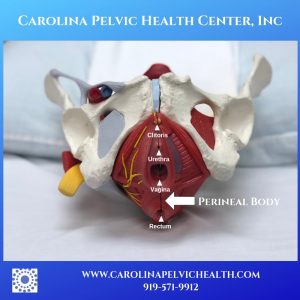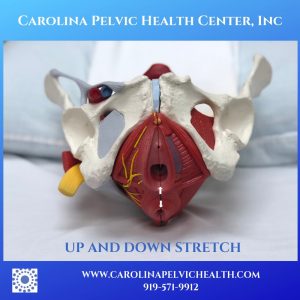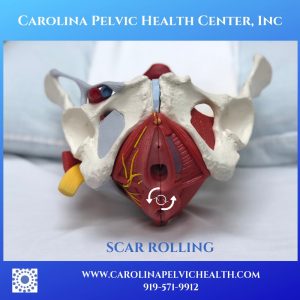 Perineal tearing and episiotomy (an incision in the perineum made by your doctor) are a common occurrence in vaginal delivery. In fact, it is reported that up to 85% of women will have some degree of perineal trauma during vaginal delivery (1-3). The body’s natural response is to form a scar where the tissues have torn. Sometimes that scar tissue can become weakened, restricted or painful, resulting in urinary and/ or fecal incontinence, painful or urgent bowel movements, or painful sex. Thankfully, pelvic floor rehabilitation is available and effective to help you recover from perineal tearing and return to intimacy and exercise comfortably and with full bladder and bowel control.
Perineal tearing and episiotomy (an incision in the perineum made by your doctor) are a common occurrence in vaginal delivery. In fact, it is reported that up to 85% of women will have some degree of perineal trauma during vaginal delivery (1-3). The body’s natural response is to form a scar where the tissues have torn. Sometimes that scar tissue can become weakened, restricted or painful, resulting in urinary and/ or fecal incontinence, painful or urgent bowel movements, or painful sex. Thankfully, pelvic floor rehabilitation is available and effective to help you recover from perineal tearing and return to intimacy and exercise comfortably and with full bladder and bowel control.
Classification of perineal tears
The medical system grades the degree of your tear base on the depth of tissue damage. See the table below for definitions of spontaneous perineal tears (3). Please note: an episiotomy by definition is a 2nd degree tear, however sometimes there is additional tearing during delivery. Ask your doctor what degree tear you experienced.
| Degree: | Tissue Trauma |
| First: | Injury to the skin only |
| Second: | Injury to the perineum muscles but not the anal sphincter |
| Third: | Injury to the perineal muscles and the external anal sphincter (EAS) |
| Fourth: | Injury to the perineal muscles, the EAS and the internal anal sphincter |
Caring for your scar
Week 1: Initial healing phase: Inflammatory phase
The body is working hard to begin healing and the immune system is activated to fight off any infections. The perineum may be red, swollen, tender or even painful.
Treatment:
(RICE)
- Rest: Take time to enjoy your baby, sleep when you can as sleep, as rest is very helpful to enhance the immune system to promote wound healing
- Ice/Compress: Cold compresses to the vaginal area are helpful to reduce pain and Inflammation. There are many options for ice perineum packs that you can find online. Here are few that our moms have enjoyed:
- VagiKool
- Instant Perineum cool packs
- Padsicles DIY perineal ice packs with witch hazel and aloe vera
- Elevate: Lie down and rest with your feet elevated above your heart to aid in circulation and reduce pressure to the perineum.
Exercise: to promote circulation and aid in healing
- Breathing exercises: Gentle diaphragmatic breathing is helpful to promote relaxation, ROM, circulation and coordination of the tissues. Try 5 minutes twice a day or a few breaths every time you feed the baby.
- Walking: gentle 5-10 minutes walks a day – let someone else carry the baby when an option
- Ankle pumps and circles: Lie down with feet elevated and circle ankles clockwise and counterclockwise and then point and flex your ankle 20-30 times a few times a day
Week 2-4: Proliferation phase: tissue closure and wound contraction
The tissues are now closing up and new blood vessels are being formed around the tear/cut however, the tissue has not returned to it normal strength or flexibility.
Treatment:
- Continue with RICE: for pain, inflammation or redness
- Continue with diaphragmatic breathing: to promote circulation and movement of the tissues
- Aerobic exercise: daily walking is an excellent form of gentle aerobic exercise to enhance circulation for tissue healing with low impact to the perineum
3 weeks to 2 years: Maturation phase
During this phase of healing the tissue is remodeling and laying down a scar and rebuilding strength and flexibility. This is a great time to begin physical therapy!
Treatment:
- Continue with recommendations as listed above for pain and swelling, circulation and aerobic exercise
- Consult a physical therapist to begin exercise, pelvic strengthening and neuromuscular retraining to address urinary or fecal incontinence and/or urgency
- Begin perineal scar massage to avoid painful intercourse and reduce pain
Self perineal scar massage:

- Find your perineum: This is the area between your vagina and anus. Use a mirror if you aren’t sure of your anatomy.
- Check with your doctor or physical therapist to ensure that the wound is closed, healed and ready for mobilization of the tissues.
- Wash hands prior to any scar mobilization to prevent infection.
- Use lubrication and apply up to moderate pressure within your tolerance.
- Position comfortably, reclined and lying on your back with head and legs supported.

Side to Side Stretch
Gently apply moderate pressure and massage along the scar and perineum region in a side to side direction.

Up and Down Stretch
Gently apply moderate pressure and massage along the scar and perineum in an up/ down direction.

Sweeping
Place your thumb at the vaginal entrance and make a “U” shape to gently stretch the muscles and scar.

Scar Rolling
Place your thumb inside the vagina and your index finger on the scar externally and massage the scar in a circular motion between your fingers like you are rubbing a pearl.
Duration: Start with gentle massage for 5 minutes every other day within your tolerance. If that is too much, reduce to every 2-3 days and if it feels comfortable you can massage the scar daily.
After massage: If your therapist recommends dilators you can proceed to dilator stretches or you may ice for 5-10 minutes to reduce pain or inflammation.
Vibration alternative: A small vibrator may be used to massage the scar to reduce pain, desensitize the scar and improve circulation to the region. Ask your therapist if a vibrator would be helpful.
When to seek professional help:
Carolina Pelvic Health Center, Inc. offers a free postpartum well visit for all of our pregnant moms who see us during their pregnancy. We recommend attending physical therapy during the maturation phase of your healing, as early as 4-6 weeks postpartum. Bear in mind that you may receive benefits from pelvic floor physical therapy even years after giving birth. It is never too late to begin pelvic floor retraining! Give us a call to learn more about how physical therapy can help you recover from childbirth and get you back to enjoy time with your growing family.
Call us for a free phone consultation @ 919.571.9912
Visit us online to learn more about our practice and how physical therapy can help you.

